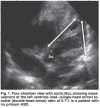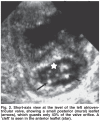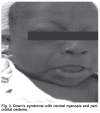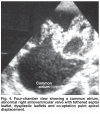Cardiac abnormalities of Sudanese patients with Down's syndrome and their short-term outcome
- PMID: 19421645
- PMCID: PMC3721669
Cardiac abnormalities of Sudanese patients with Down's syndrome and their short-term outcome
Abstract
Background: Congential heart disease (CHD) is an important cause of morbidity and mortality in patients with Down's syndrome (DS).
Methods: All patients with DS seen at the Sudan Heart Centre from July 2004 to November 2007 were included in the study. All patients were examined clinically and echocardiographically, and cardiac catheterisation was carried out in selected patients. All patients were prospectively followed up.
Results: In the study period, 1 566 patients were evaluated for heart disease. Of these, 80 patients with DS were identified (5%). Their ages ranged from 15 days to 18 years. Cardiac abnormalities included atrioventricular septal defect (AVSD) in 38 patients (48%), with the complete form in 25, a partial form in seven, AVSD with intact atrial septum in one, and complex AVSD in four patients. In one patient there was AVSD with right atrioventricular valve malformation with severe valve regurgitation and functional pulmonary atresia. The other main lesions were ventricular septal defect (VSD) in 19 patients (23%) and tetralogy of Fallot (TOF) in five (6%). Cardiac catheterisation was done in four patients with AVSD to measure pulmonary pressures and resistance, and in one patient with patent ductus arteriosus for device closure. Ten percent of the patients had Eisenmenger's syndrome at the time of presentation. Only 15% of patients who were in need of surgery were operated on; all had an uneventful postoperative course and a good outcome at a mean follow-up period of one year.
Conclusion: The pattern of CHD in Sudanese patients with DS was comparable with that in the literature, including the rare occurrence of AVSD with intact atrial septum. In addition, we described an unreported association with right atrioventricular valve malformation. Although there was a significant delay in diagnosis and surgery, surgical results and short-term follow up were good.
Figures




Similar articles
-
Survival analysis of Down syndrome with congenital heart disease: a 5-years registry at QSNICH.J Med Assoc Thai. 2014 Jun;97 Suppl 6:S108-14. J Med Assoc Thai. 2014. PMID: 25391181
-
Surgical experience with congenital heart disease in Down's syndrome.Indian Heart J. 2000 Jul-Aug;52(4):438-41. Indian Heart J. 2000. PMID: 11084787
-
Congenital heart disease in children with Down's syndrome: Turkish experience of 13 years.Acta Cardiol. 2008 Oct;63(5):585-9. doi: 10.2143/AC.63.5.2033225. Acta Cardiol. 2008. PMID: 19014001
-
Congenital cardiovascular malformations in Chinese children with Down's syndrome.Chin Med J (Engl). 1989 May;102(5):382-6. Chin Med J (Engl). 1989. PMID: 2530065 Review.
-
Better surgical prognosis for patients with complete atrioventricular septal defect and Down's syndrome.Ann Thorac Surg. 2004 Aug;78(2):666-72; discussion 672. doi: 10.1016/j.athoracsur.2003.12.021. Ann Thorac Surg. 2004. PMID: 15276542 Review.
Cited by
-
Down syndrome in Africa: Challenges, opportunities, and future directions.Alzheimers Dement. 2025 Jun;21(6):e70388. doi: 10.1002/alz.70388. Alzheimers Dement. 2025. PMID: 40538002 Free PMC article.
-
Pediatric cardiac services in Sudan: Achievements, challenges, and future perspectives (2004-2021).Front Pediatr. 2022 Nov 9;10:793188. doi: 10.3389/fped.2022.793188. eCollection 2022. Front Pediatr. 2022. PMID: 36440339 Free PMC article. Review.
-
Cardiovascular disease in children in Djibouti: a single-centre study.Pan Afr Med J. 2013 Apr 9;14:141. doi: 10.11604/pamj.2013.14.141.2016. Print 2013. Pan Afr Med J. 2013. PMID: 23785546 Free PMC article.
-
Down syndrome and congenital heart disease: why the regional difference as observed in the Libyan experience?Cardiovasc J Afr. 2011 Nov-Dec;22(6):306-9. doi: 10.5830/CVJA-2010-072. Cardiovasc J Afr. 2011. PMID: 22159317 Free PMC article.
-
The spectrum of congenital heart diseases in down syndrome. A retrospective study from Northwest Saudi Arabia.Saudi Med J. 2016 Jul;37(7):767-72. doi: 10.15537/smj.2016.7.14536. Saudi Med J. 2016. PMID: 27381537 Free PMC article.
References
-
- Park SC, Mathews RA, Zuberbuhler JR, Rowe RD, Neches WH, Lenox CC. Down syndrome with congenital heart malformation. Am J Dis Child. 1977;1:29–33. - PubMed
-
- Parvathy U, Balakrishnan KR, Ranjith MS, Saldanha R, Sai S, Vakamudi M. Surgical experience with congenital heart disease in Down’s syndrome. Indian Heart J. 2000;4:438–441. - PubMed
-
- Wells GL, Barker SE, Finley SC, Colvin EV, Finley WH. Congenital heart disease in infants with Down’s syndrome. South Med J. 1994;7:724–727. - PubMed
-
- Sulafa AK, Tamimi O, Najm HK, Godman MJ. Echocardiographic differentiation of atrioventricular septal defects from inlet ventricular septal defects and mitral valve clefts. Am J Cardiol. 2005;5:607–610. - PubMed
-
- Silverman NH, Ho SY, Anderson RH, Smith A, Wilkinson JL. Atrioventricular septal defect with intact atrial and ventricular septal structures. Int J Cardiol. 1984;55:567–573. - PubMed
Publication types
MeSH terms
LinkOut - more resources
Full Text Sources
Medical

